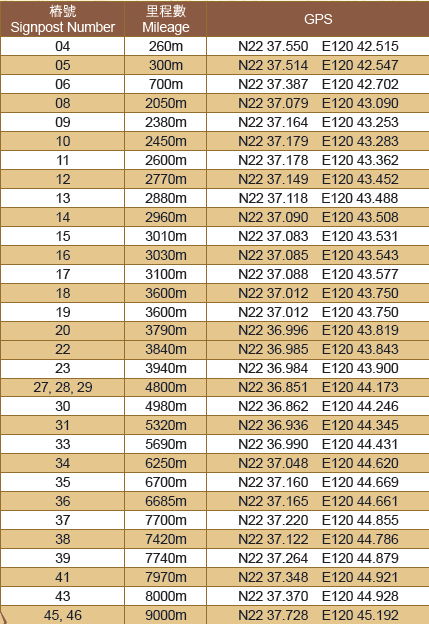Mileage Coordinate Reference

Self-Guided Hiking Trail Guide
Station 4:
Variations in Mountain Beidawu forest physiognomy. Between 1540-1800 m is a warm temperate broadleaf forest; dominant species include laurel and Fagaceae trees. Between 1800-2500 m is a warm temperate coniferous and broad-leaved mixed forest; the dominant species is the Taiwan red cypress. Beyond 2500 m is a cool temperate broadleaf forest; the dominant species is the Taiwan hemlock.
Station 5:
Common mammals in Mountain Beidawu include the Formosan rock macaque, Formosan serow, Siberian weasel, yellow-throated marten, white-faced flying squirrel and Formosan striped squirrel.
Station 6:
Epiphytic plants are classified into five types including epiphytes, climbers, stranglers, hemiparasites and parasites. Common species include the green penny fern, Japanese felt fern, Lepisorus and rock-ginger fern.
Station 8:
Taiwan plum yews grow in the forest at elevations ranging between 650-2700 m. The greatest difference between the Taiwan plum yew and the Taiwan yew is the presence of distinct white stomatal bands on the underside of its leaves, as well as its oval shaped drupes.
Station 9:
The Prunus campanulata, also known as the Taiwan cherry, is native to broadleaf forests at elevations ranging between 500-2000 m. Once these trees bloom, they produce fruits which are loved by birds. These fruits often attract large numbers of birds to the trees.
Station 10:
The green maple grows in the forest at elevations ranging between 500-2000 m. Its leaves usually have five lobes. Every autumn and winter, as the temperatures fall, the leaves of the green maple gradually change from green to yellow to red. The fruits produced by the green maple are samara.
Station 11:
Mountain Beidawu is one of the Taiwan yew’s native habitats. The wood of the Taiwan yew is often used for furniture or carving. The location of this station is surrounded by both Taiwan yews and Elaeocarpus trees.
Station 12:
The fruits of the Chinese knotweed found along the trail are the Swinhoe’s pheasant’s favorite food. The Swinhoe’s pheasant is endemic to Taiwan and a target for conservation. They are found in low to mid-range elevation forests at about 300-2000 m above sea level.
Station 13:
The humus and moss layer refers to the layer of green moss covering the soil beneath the rhododendron forest, similar to a soft carpet. This layer also acts as a habitat for many small animals.
Station 14:
The fruits of Elaeocarpus trees resemble olives. These trees are often planted in courtyards and along paths.
Station 15:
Conservation of roots, soil, and water. As trees grow, they absorb nutrients from the soil through their roots. This in turn allows the roots to branch out further and absorb even more nutrients. The expansive root system of the rhododendron forest, along with the rich humus layer and groundcover vegetation, enable water conservation in the forest.
Station 16:
The flowering dogwood is a rare and valuable flower with four white petals. It is distributed among low to mid-elevation forests and blooms each year during late April.
tation 17:
The Taiwan rhododendron is the largest species of rhododendron in Taiwan. Its primary feature is the gray and brown fuzz on the underside of each leaf. The Taiwan rhododendron blooms each year during April and May; its flowers are white or light magenta in color.
Station 18:
The leaves of the Taiwan red maple have five lobes with shallow incisions and turn red in autumn due to low temperatures, much like the green maple. However, the leaves of the Taiwan red maple are red in color even during spring.
Station 19:
The Arishan hornbeam, also known as the Kawakamii hornbeam, is a common color-changing plant in the Mountain Beidawu area. The leaves of this tree have double serrated edges.
Station 20:
The Taiwan pleione is a representative mountain orchid native to Taiwan. It blooms during March and April and yields a single flower, although occasionally two may be observed. The flowers may be pink, lavender, or deep purple in color. Please do not pluck the flowers so that everyone may enjoy them.
Station 22:
The Mikado pheasant is a species of bird endemic to Taiwan.
Station 23:
Burls form when the branches of a tree are injured and sealed by oozing sap to prevent invasion and damage by insects and bacteria. Over time, the seal becomes a unique burl.
Station 27:
The source of the Walusi River is located upstream of Donggang River while the valley surrounded by Ritangzhen Mountain, Mountain Beidawu and
South Dawu Mountain acts as its catchment.
Station 28:
The Rhododendron ellipticum blooms every year from March to June, producing pink flowers.
Station 29:
Landslides occur when gravity causes the edge of a slope to slide downwards or collapse and create a mass movement.
Station 30:
Taiwan schefflera.
Station 31:
A rich variety of ferns.
Station 33:
Mixed Taiwan red cypress and Taiwan hemlock forest.
Station 34:
Shelu River source.
Station 35:
Functions of fallen trees.
Station 36:
Taiwan hemlock.
Station 37:
Red-hairy rhododendron.
Station 38:
Taiwan alpine rhododendron.
Station 39:
Taiwan pieris.
Station 41:
Yushan cane.
Station 43:
Flowering mountain groundcover plants.
Station 45,46:
Overlooking the Pingtung Plains and Taiwan Strait. Overlooking the Taitung Plains and Pacific Ocean.
